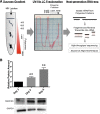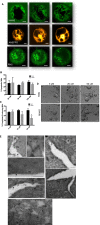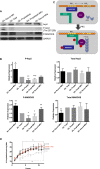Synthesis and dephosphorylation of MARCKS in the late stages of megakaryocyte maturation drive proplatelet formation
- PMID: 26744461
- PMCID: PMC4797023
- DOI: 10.1182/blood-2015-08-663146
Synthesis and dephosphorylation of MARCKS in the late stages of megakaryocyte maturation drive proplatelet formation
Abstract
Platelets are essential for hemostasis, and thrombocytopenia is a major clinical problem. Megakaryocytes (MKs) generate platelets by extending long processes, proplatelets, into sinusoidal blood vessels. However, very little is known about what regulates proplatelet formation. To uncover which proteins were dynamically changing during this process, we compared the proteome and transcriptome of round vs proplatelet-producing MKs by 2D difference gel electrophoresis (DIGE) and polysome profiling, respectively. Our data revealed a significant increase in a poorly-characterized MK protein, myristoylated alanine-rich C-kinase substrate (MARCKS), which was upregulated 3.4- and 5.7-fold in proplatelet-producing MKs in 2D DIGE and polysome profiling analyses, respectively. MARCKS is a protein kinase C (PKC) substrate that binds PIP2. In MKs, it localized to both the plasma and demarcation membranes. MARCKS inhibition by peptide significantly decreased proplatelet formation 53%. To examine the role of MARCKS in the PKC pathway, we treated MKs with polymethacrylate (PMA), which markedly increased MARCKS phosphorylation while significantly inhibiting proplatelet formation 84%, suggesting that MARCKS phosphorylation reduces proplatelet formation. We hypothesized that MARCKS phosphorylation promotes Arp2/3 phosphorylation, which subsequently downregulates proplatelet formation; both MARCKS and Arp2 were dephosphorylated in MKs making proplatelets, and Arp2 inhibition enhanced proplatelet formation. Finally, we used MARCKS knockout (KO) mice to probe the direct role of MARCKS in proplatelet formation; MARCKS KO MKs displayed significantly decreased proplatelet levels. MARCKS expression and signaling in primary MKs is a novel finding. We propose that MARCKS acts as a "molecular switch," binding to and regulating PIP2 signaling to regulate processes like proplatelet extension (microtubule-driven) vs proplatelet branching (Arp2/3 and actin polymerization-driven).
Figures







Similar articles
-
Pivotal role of PDK1 in megakaryocyte cytoskeletal dynamics and polarization during platelet biogenesis.Blood. 2019 Nov 21;134(21):1847-1858. doi: 10.1182/blood.2019000185. Blood. 2019. PMID: 31578203
-
Platelet secretion induced by phorbol esters stimulation is mediated through phosphorylation of MARCKS: a MARCKS-derived peptide blocks MARCKS phosphorylation and serotonin release without affecting pleckstrin phosphorylation.Blood. 2000 Feb 1;95(3):894-902. Blood. 2000. PMID: 10648401
-
Phospho-inositide-dependent kinase 1 regulates signal dependent translation in megakaryocytes and platelets.J Thromb Haemost. 2020 May;18(5):1183-1196. doi: 10.1111/jth.14748. Epub 2020 Mar 5. J Thromb Haemost. 2020. PMID: 31997536 Free PMC article.
-
Calmodulin and protein kinase C cross-talk: the MARCKS protein is an actin filament and plasma membrane cross-linking protein regulated by protein kinase C phosphorylation and by calmodulin.Ciba Found Symp. 1992;164:145-54; discussion 154-61. doi: 10.1002/9780470514207.ch10. Ciba Found Symp. 1992. PMID: 1395931 Review.
-
Interpreting the developmental dance of the megakaryocyte: a review of the cellular and molecular processes mediating platelet formation.Br J Haematol. 2014 Apr;165(2):227-36. doi: 10.1111/bjh.12758. Epub 2014 Feb 6. Br J Haematol. 2014. PMID: 24499183 Review.
Cited by
-
Sequence-specific 2'-O-methoxyethyl antisense oligonucleotides activate human platelets through glycoprotein VI, triggering formation of platelet-leukocyte aggregates.Haematologica. 2022 Feb 1;107(2):519-531. doi: 10.3324/haematol.2020.260059. Haematologica. 2022. PMID: 33567808 Free PMC article.
-
Lung megakaryocytes engulf inhaled airborne particles to promote intrapulmonary inflammation and extrapulmonary distribution.Nat Commun. 2024 Aug 27;15(1):7396. doi: 10.1038/s41467-024-51686-y. Nat Commun. 2024. PMID: 39191805 Free PMC article.
-
PKC-epsilon deficiency alters progenitor cell populations in favor of megakaryopoiesis.PLoS One. 2017 Aug 4;12(8):e0182867. doi: 10.1371/journal.pone.0182867. eCollection 2017. PLoS One. 2017. PMID: 28783756 Free PMC article.
-
Selinexor-induced thrombocytopenia results from inhibition of thrombopoietin signaling in early megakaryopoiesis.Blood. 2017 Aug 31;130(9):1132-1143. doi: 10.1182/blood-2016-11-752840. Epub 2017 Jun 19. Blood. 2017. PMID: 28630120 Free PMC article. Clinical Trial.
-
High-content, label-free analysis of proplatelet production from megakaryocytes.J Thromb Haemost. 2020 Oct;18(10):2701-2711. doi: 10.1111/jth.15012. Epub 2020 Aug 23. J Thromb Haemost. 2020. PMID: 32662223 Free PMC article.
References
-
- Machlus KR, Thon JN, Italiano JE., Jr Interpreting the developmental dance of the megakaryocyte: a review of the cellular and molecular processes mediating platelet formation. Br J Haematol. 2014;165(2):227–236. - PubMed
-
- DHHS. The 2011 national blood collection and utilization survey report. Department of Health and Human Services; 2013.
-
- Thon JN, Macleod H, Begonja AJ, et al. Microtubule and cortical forces determine platelet size during vascular platelet production. Nat Commun. 2012;3:852. - PubMed
Publication types
MeSH terms
Substances
Grants and funding
LinkOut - more resources
Full Text Sources
Other Literature Sources
Molecular Biology Databases
Research Materials
Miscellaneous

